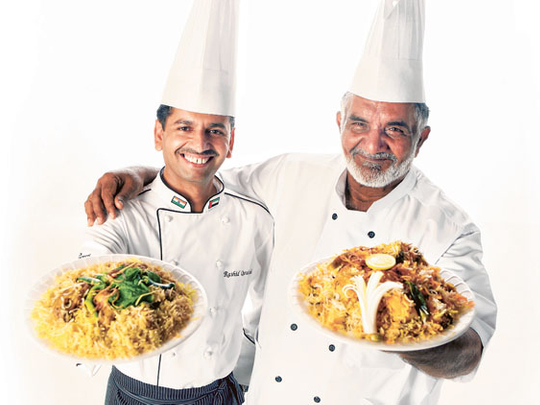
Dubai: Even emperors are prone to stomach rumblings. Whenever Babur, the first of the Mughals to invade India in 1526 AD, found a few idle hours between masterminding blood-soaked battles and overseeing a shaky administration in the Delhi sultanate, he ached for the taste of the fruits of Kabul, the land he loved so much and left behind — sweet melons, plump pomegranates, honeyed grapes, and the finest dried fruit. And when the bouts of longing turned severe, he had caravans of fruit trundle towards him in Delhi.
While this brand of food nostalgia didn't strike his grandson Akbar (1556-1605), the refinement and richness inherent in Babur's lineage — Turkish roots and Mongol blood with the gloss of Persian influence — led to the acme of culinary explorations during Akbar's rule. The royal kitchens of Jalaluddin Mohammad Akbar cooked up a staggering array of dishes that endure in their incomparable appeal today. Sherbet, falooda, halwa, naan, kebabs, qaliya, shorba — foods that weigh down festive tables across the subcontinent today — were all born in this era.
What was not born at this time, however, was the biryani. This classic dish, says New Delhi-based food historian Salma Hussain, was about 200 years away from its glorious beginnings. "The biryani as we know it today is believed to have made its appearance during the reign of Bahadur Shah Zafar (1775-1862), the last Mughal ruler."
Though there is no definite text available to authenticate this, historians following the aromatic trail of the biryani travel back to the royal kitchens of Qila Mualla in Dilli, says Hussain.
The Qila Mualla is the original name for the famous Red Fort in New Delhi, from where Bahadur Shah Zafar ruled. (The Red Fort or Lal Qila was built by the Mughal Emperor Shah Jahan after he transferred his capital to his newly planned city of Shahjahanabad, now old Delhi, from Agra in 1638.) But before the saga of biryani can be told, the history of pulao needs to be sampled.
Some historians date the first proper documentation of the pilaf recipe to the early 10th century in Central Asia, though others point to Alexander the Great having been served the dish when he conquered ancient Persia. From the myriad versions the pulao enjoyed in Central Asia, the Middle East and Turkey many centuries ago, it was the Iranians who raised it to a fine art.
"The art of the pulao belongs to the Iranians," says Hussain. "It showed the world how the cooking of rice can be perfected.
"In the preparation of pulao" she says, "not every grain of rice acquires the taste and aroma of the meat and the spices used in its cooking. In the pulao of ancient times, the main ingredients were placed on top, the sides or in between the heap of pulao rice."
Celebration of taste
A form of separatism has been pursued by biryani masters down the centuries, albeit with a slight difference. The classical Persian pulao of ancient times called for the rice and meat to be cooked separately and then co-arranged. On the other hand, the biryani evolved with the meat and rice being cooked together, but in separate layers in the pot. It's only on the plate, after the biryani was served that you introduced the meat and rice to each other and the glorious celebration of taste and flavour began.
The pulao, was, and is, a one-pot meal that enjoys a delicacy of aroma and taste that contrasts with its flashy and robust offspring. The source code of the biryani, says Hussain, is the Persian word ‘Biryon" which means ‘fried, broiled and roasted until cooked'. The ancient Persian lughats (dictionaries) describe the original pulao thus:
"Pukhtan-e-Goosht Bee Aab,
Cheh Dar Dum Wa Cheh Bar Aatish,
Wa Surkh Kardan, Wa Boo Dadan,
Aanhaast Dar Roghan".
(Cooking meat without water, either in a sealed pot or open vessel on heat, frying and cooking in oil and aromatic herbs).
The biryani however ended up being resplendently enriched with spices, vegetables, dried fruit, exotic infusions and breakthrough cooking methods like the ‘dum' (sealing the mouth of the pot with a ring of dough and allowing the steam to cook the contents).
Once the biryani emerged from the royal pots, it wasn't long before it beguiled the common man. During the 19th century, it underwent an astonishing number of glorious redefinitions, across the length and breadth of pre-partition India.
Today, both India and Pakistan offer a stunning array of biryanis that revel in regional flavours while celebrating their common ancestry.
The dish brings together the people of the two countries on a common platform that accords equal space to shared heritage and individualistic excellence.
Regarding the astonishing versatility and adaptability of the biryani, Hussain says: "The great thing about a living tradition is its representation of continuity and change that is imaginatively blended. Food is an evolution, some dishes are created, some are adapted, while others get buried in the crypt of time."
The biryani has become one of those extraordinary culinary creations of history that, happily, will not go the way of it.











